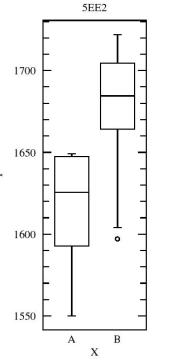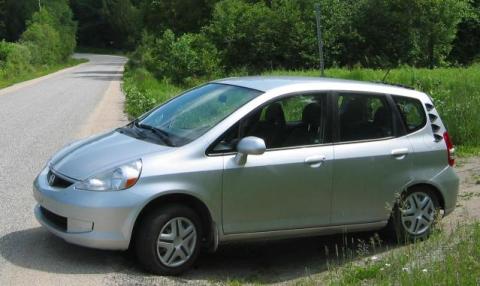Airtab Vortex Generators on the Honda Fit


So, I stuck some Airtabs on my Honda Fit, just to see what they would do.
They're vortex generators designed to be
attached to the body of vehicles that have a big flat surface at the back. The vortices thus generated are said to let the air flow more
smoothly off the edge, reducing drag at speeds above 40mph. Of course, they won't do anything much at lower speeds, or on Kammback-style cars like the
Honda Insight.
The Fit has a big flat vertical hatchback and a nice streamlined front-end, so I guess it's something close to
the ideal shape for adding some vortex generators.
Searching the web turned up little in the way of published data on the effectiveness of these things, but some reason to think that they
should work in theory.
According to the Airtab website, NASA found them to be the lowest-drag vortex generators around.
So I decided to try them for myself. I found that they do actually improve the aerodynamic performance
of the Fit.
Coast-Down Test
Suspecting that whatever increase vortex generators might give in fuel economy would be too small to easily see, I wanted to be certain that they would help rather than hurt the
performance of the car. So, a coast-down test seemed like the thing to do.
I went out to a nice straight, flat, and empty stretch of road to attempt to measure the time it took to coast down from 100 to 70km/h.
Unfortunately, the winds were strong and variable that day, and the results I got looked mostly random.
One of the local residents was curious as to why I was driving up and down the road in front of his house, but he seemed to buy the explanation that I was experimenting with aerodynamic devices.
Although the airtabs possibly showed a slight improvement, this first test was a complete failure, with far too much noise compared to signal.
Despite the shifting winds, my times were getting a bit more consistent near the end. I guess the trick of keeping a constant speed to exactly the right point
on the road, then starting the timer exactly simultaneously with pushing the clutch pedal took me a while to learn.
Having exhausted the large part of my patience for repeatedly driving up and down the same stretch of road, I nonetheless went out for another try, on another day.
This time, no really ideal place for testing was close by, and I didn't have time to drive very far. I found something that looked good enough. It's a nice little stretch of road, sheltered from the
wind, though there wasn't much wind this time. The straight was a little shorter than I'd have liked, and had sharp curves at either end. It was just long enough to get up to 100km/h and
to coast down to 80 with a bit of room to spare for braking for the rapidly-approaching corner. The results of this test look considerably more meaningful.

I ran four sets of tests, two with the Airtabs taped on, two without. I attached the airtabs to the car with metal foil tape. For B1, I put eight Airtabs along the roofline. For B2, I also added
four on each side.
| A1-Base | B1-Airtab | A2-Base | B2-Airtab |
|---|---|---|---|
| 1550 | 1691 | 1628 | 1597 |
| 1647 | 1678 | 1623 | 1662 |
| 1607 | 1700 | 1649 | 1722 |
| 1706 | 1671 |
Overall, the average time (in hundredths of a second) for both sets of test runs with Airtabs was 1678, 3.77% greater than the average
times for the unmodified car of 1617. Seemingly not a huge difference, but it is
very much statistically significant, according to this web t-test
calculator, which claims that the probability of this event, assuming the null hypothesis, is 0.011.
The first run in set B2 was anomalously slow. I suspect this could be the result of the car cooling down (most importantly, I guess, the tires) while I took my time taping the Airtabs back on. Also, it started raining very lightly during the last run, again putting the Airtabs at a disadvantage.
Those are the times in one direction; on the way back from each run, I measured the time in the other direction. The times going the other
way were shorter, indicating that it was slightly more uphill on average that way. It was also on a slightly different section of road, with a few more bumps
in it. The part of the road that was straight was too short to do any better. The straight was slightly bowl-shaped, so it was actually going up a very slight
grade in the last part in each direction. In this other direction, whatever difference the airtabs made
was not statistically significant, though they still showed a slight gain. Counting this, it took me three attempts to get a proper test done,
so at this point I felt about (1-0.011)3=96.7% certain that the Airtabs improve things.
The average speed of each run was somewhere less than 90km/h, since the car slows down more quickly at higher speeds. Since most of my
highway driving is a bit faster than that, whatever saving in fuel consumption is represented by this test (which would be impossibly difficult to calculate
anyway) should be exceeded, I think, in normal driving. The road surface in the test was tar-and-chip, in somewhat worse shape
than the average highway.
Despite the fact that this coast-down test gives no specific indication of what I can expect in improved fuel economy, it does suggest that there
should be a substantial improvement, with the effect being large enough to measure even under these adverse test conditions.
More Observations

Since sticking the airtabs on permanently, I've gone back to my normal driving routine. The wind noise in the car is changed in tone a little, but doesn't seem any louder. The car does seem more stable in gusts of wind, but that's a subjective impression I don't trust very much yet, having not
recently encountered any really strong winds.
Initially I just put two on each side. I've since added two more, for a total of 16 Airtabs on the car.
The surface is more flat where I put the first two pairs, making them easier to install there. I used some waterproof "goop" to fill the gap where the body curves
away from the backing of the Airtabs on the second two. Since having 4 on each side, they do seem to keep the rain
off the back window; they didn't with only 2.
To my great surprise, the car requires noticeably less throttle position to keep it going at speeds anywhere above 80km/h (50mph).
When I first got the Fit, it took a while to get used to the fact that it requires, compared to my previous car, such a light touch on the
gas pedal to maintain a constant speed on the highway. That feeling is back. It also seems to have much more power to spare at high speed.
I'm fairly confident that top speed would now be somewhere in the vicinity of 120mph where it would be approaching the redline in top gear.
I haven't had any suitable opportunity to verify that in practice.
Recent Fuel Consumption
I've been keeping track of fuel consumption since I've had the car, but not recording the results. The average was
somewhere around 6.5L/100km over the last few tanks of gas with the car entirely unmodified. That's 36 miles per US gallon, similar to what others have reported for the manual Fit,
and slightly better than the (2008-comparable) EPA highway rating.
The great majority of my daily driving is on the highway, with speed limits from 70 to 100km/h. Most often I cruise at a bit less than 100km/h (62mph).
The best fuel consumption number I remember seeing before Airtabs was 6.2L/100km (38mpg), the worst 7.1 (33mpg).
The 25.40 litres of gas consumed during the coast-down testing (including the drive to and from the test sites)
was good for 402.9km, giving 6.30L/100km (37.3mpg). I thought this rather good,
since rapidly accelerating to 100km/h, coasting down a bit, then braking to a stop to turn around and do it again is probably not the most efficient way to drive.
I didn't include it in the average fuel consumption since installing airtabs.
Impatient to see some results, I filled it up again after only 109.4km of normal driving, including some
driving with the windows down, and some excessively high speed.
The result looks better than expected. I will
continue to log fuel consumption here for a while, until there's enough data for a more reliable estimate.
This weekend of July 1, I drove it a bit harder than normal, to say the least.
I'm beginning to suspect that 120km/h (with a headwind that made the airspeed more like 160)
might be a bit too fast for optimal fuel economy, and
during the weekend I spent some time at higher speeds.
The Airtabs don't help the quarter-mile time in any noticeable way, at least not when the driver
doesn't have any idea how to get a good launch (too much wheelspin).
So I tried driving efficiently for a bit, but it didn't seem to make any big difference,
so I gave up on that.
The high variability of the fuel consumption measurements seems to indicate
that it might take a while for the average to be all that meaningful.
| Date | km | Litres | L/100km | MPG(US) | Notes |
|---|---|---|---|---|---|
| Pre-Airtabs | 6.5 | 36 | Approximate | ||
| 2007-06-22 | 109.4 | 6.00 | 5.49 | 42.9 | |
| 2007-06-24 | 138.0 | 7.89 | 5.72 | 41.15 | |
| 2007-06-26 | 169.7 | 8.77 | 5.17 | 45.51 | Now 4 on each side. |
| 2007-06-29 | 216.1 | 13.66 | 6.32 | 37.21 | More city driving than usual (about 50%) |
| 2007-06-29 | 398.0 | 27.11 | 6.81 | 34.53 | 120km/h+ (75mph) on highway 401, strong headwind. |
| 2007-07-01 | 550.7 | 37.81 | 6.87 | 34.26 | High speeds, Toronto city driving, some drag racing. |
| 2007-07-01 | 383.5 | 21.75 | 5.67 | 41.47 | 115km/h (71mph) on the 401, light crosswinds, some rain. |
| 2007-07-05 | 193.6 | 10.15 | 5.24 | 44.87 | |
| 2007-07-08 | 155.1 | 9.75 | 6.28 | 37.41 | |
| 2007-07-11 | 164.1 | 10.27 | 6.26 | 37.59 | |
| 2007-07-17 | 262.8 | 14.40 | 5.48 | 42.93 | |
| 2007-07-25 | 186.3 | 12.46 | 6.69 | 35.16 | |
| 2007-07-29 | 226.2 | 12.40 | 5.48 | 42.92 | |
| 2007-07-31 | 333.9 | 19.45 | 5.83 | 40.38 | |
| 2007-07-31 | 333.4 | 21.70 | 6.51 | 36.14 | |
| 2007-08-05 | 268.7 | 15.02 | 5.59 | 42.08 | |
| 2007-08-12 | 258.6 | 15.55 | 6.01 | 39.12 | |
| 2007-08-13 | 503.3 | 29.59 | 5.88 | 40.01 | |
| Total: | 4851.4 | 293.73 | 6.06 | 38.85 | Since installing Airtabs |